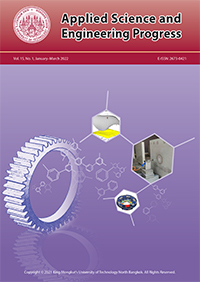Improvement of Sheet Metal Properties by Inducing Residual Stresses into Sheet Metal Components by Embossing and Reforming
Main Article Content
Abstract
In sheet metal forming, combination of embossing and reforming allows the mechanical properties of sheet metal materials to be specifically improved. Here, local property modification is achieved by the residual stresses induced as a result of the one-sided embossing process followed by a reforming step. The residual stresses induced in this specific way can lead to a significantly increase in the fatigue strength of processed sheet metal components. However, in order to ensure this kind of component optimization in continuous operation, the induced stresses have to be homogeneous. In this respect, the main objective of the study reported about in this paper was to identify a forming strategy, consisting of the process steps embossing and reforming, that generates preferably homogeneous residual stress distributions into sheet metal blanks. For this, numerical and experimental investigations were carried out with samples of the stainless steel (X6Cr17) having a thickness of 1.5 mm. It was found that embossing and reforming, integrated into a conventional forming process, is a novel approach to specifically induce very localized homogeneous compressive residual stresses in sheet metal materials. This eliminates the need for costly post-processing by means of surface treatment.
Article Details
References
[2] H. Behnken and V. Hauk, “On the influence of microresidual stresses during cyclic loading,” in Residual Stresses. Germany: Oberursel, 1993, pp. 733 – 742.
[3] E. R. de los Rios, A. Walley, M. Milan, and G. Hammersley, “Fatigue crack initiation and propagation on shot-peened surfaces in A316 stainless steel,” International Journal of Fatigue, vol. 17, no. 7, pp. 493–499, 1995.
[4] H. E. Friedrich, Leichtbau in der Fahrzeugtechnik. Hessen, Germany: Springer Fachmedien, 2013
[5] M. Liewald, R. Schleich, D. Vlahovic, and M. Sindel, “Einfluss dehnungsabhängiger werkstoffeigenschaften auf die umformbarkeit von blechwerkstoffen,” in Materialwissenschaft und Werkstofftechnik. Weinheim, Germany: Wiley-VCH-Verlag, 2007.
[6] Toyota, ”Toyota Motor Corporation,” 2021. [Online]. Available: https://global.toyota/en/
[7] E. Kröner, “Berechnung der elastischen konstanten des vielkristalls aus den konstanten des einkristalls,” Zeitschrift für Physik, vol. 151, no. 4, p. 504, 1958.
[8] R. Hill, “A theory of the yielding and plastic flow of anisotropic metals,” Proceedings of the Royal Society A: Mathematical, Physical and Engineering Sciences, vol. 193, no. 1033, p. 281, 1948.
[9] E. Doege and B.-A. Behrens, “Gründliche und kompakte darstellung der umformtechnik,” in Handbuch Umformtechnik. Berlin, Germany: Springer, 2016.
[10] E. Macherauch and P. Müller, “Das sin²ψ-Verfahren der röntgenographischen spannungsmessung,” Zeitschrift für angewandte Mathematik und Physik, vol. 13, pp. 305–312, 1961.
[11] U. Wolfstieg, “Die Symmetrisierung unsymmetrischer interferenzlinien mit hilfe von spezialblenden,” Haerterei-Technische Mitteilungen, vol. 31, pp. 23–26, 1976.
[12] V. Hauk and H.-J. Nikolin, “The evaluation of the distribution of residual stresses of the I. kind (RS I) and of the II. kind (RS II) in textured materials,” Textures and Microstructures, vol. 8–9, pp. 693– 716, 1988.

